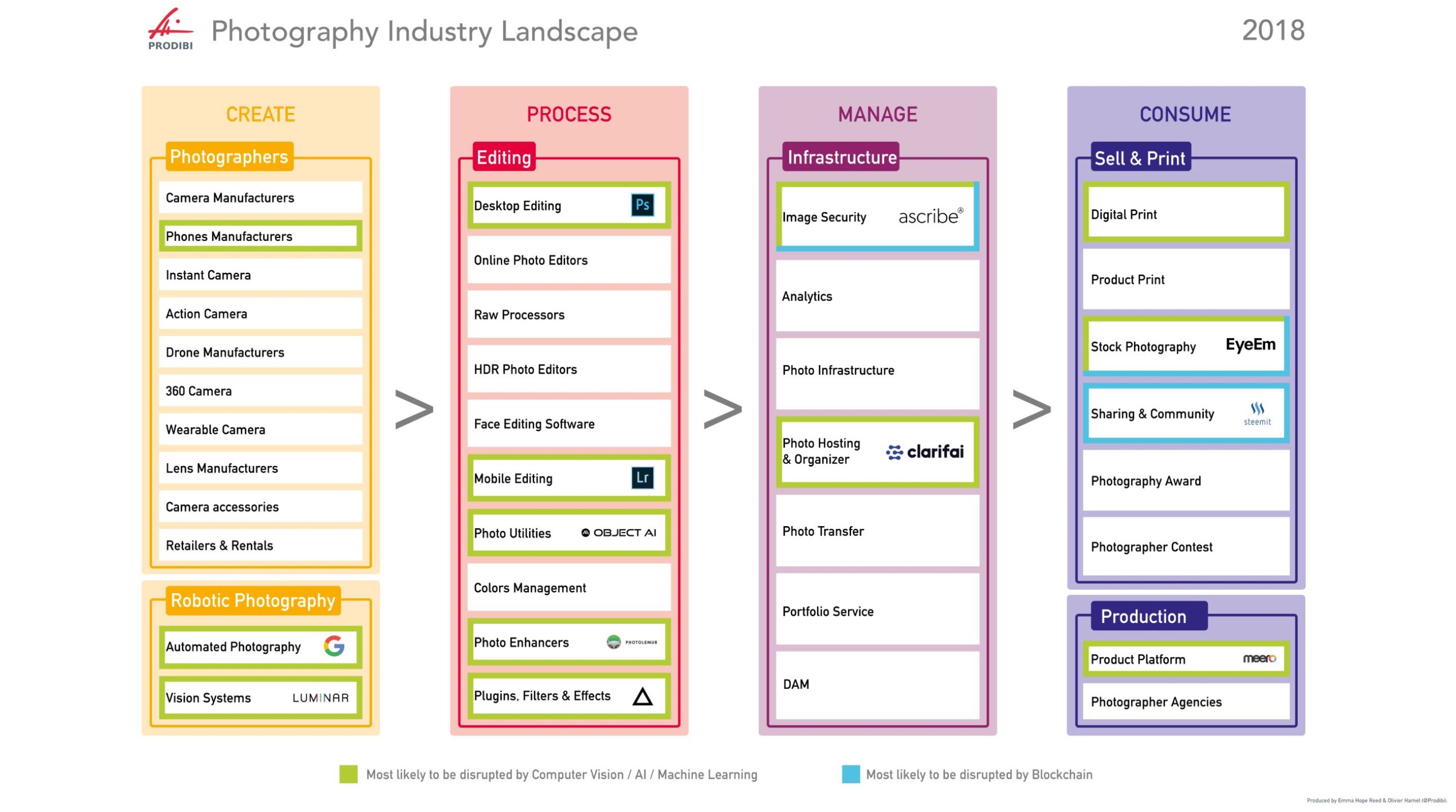Taylor Davidson · The Photography Industry Landscape
New Thanks to Olivier Hamel of Prodibi.
In 2013 I created a Photography Industry Landscape to create a structured way of thinking about the value chain of the photography industry. [1] Suffice it to say, a lot has changed since then; obviously many of the companies have disappeared or merged, and the buckets have grown larger or smaller with shifts in value over time, and required a refreshed look at the industry. Thanks to Olivier Hamel of Prodibi for updating the approach and the landscape presented here.
What’s New?
My core construct behind the original photography landscape was to map how a photo is shared through the value chain, from creating (camera manufacturers), to editing, to sharing, storing, printing, selling, and using. When I started writing and thinking about the photography business (circa 2007), saying “everyone is a photographer” was edgy enough to warrant a SXSW talk, but today, a few billion photos later, it’s faded deep into the background. Yes, we all take photos, so what?
As I look back since I started writing about photography in 2007, as our days became flooded with imagery, companies that have adapted to the flow, rather the stock of photography have largely been the winners. A camera in every pocket, connected to any network, delivering photos to everyone’s feed, from experience to edit to likes in seconds, and if you aren’t empowering that experience, you had better be differentiated. [2] Many of the companies on my 2013 landscape have folded, faded, or been merged into other companies, shifting with the times as the value of the buckets has changed over time. Consumer photo sharing, editing, storage and management, have largely been consolidated into larger companies - Apple, Google, Facebook, Amazon et. al. - mainly to shore up the customer relationships with their core products. Stock photography adapted - is always adapting - to changing norms around brands, imagery, and what people want to see, powered by companies like EyeEm, Unsplash, and others. The value of the infrastructure applications, image security, and image analytics have been consolidated into adjacent value chains, with the acquisitions of many of the companies listed in the landscape into larger marketing platforms and content companies.
What we looked to add to this version of the landscape was a hint on what’s coming next. Computer vision, artificial intelligence, and machine learning have been areas of development and investment for the established players and new companies, and should have an impact on many of the areas on the landscape, notably phone manufacturers, photo editing, photo security, management and organizing, sharing, and stock photography. Essentially, any part of the value chain that is based on the flow of photographs will be impacted by new technology that onramps, structures, or delivers that flow. [3]
In a similar vein, blockchain and distributed ledger technologies are creating new opportunities for stock, security, and sharing companies around image rights, ownership, verification, and tracking.
Using the Landscape
The goal of the landscape has always been to create a common structure for innovators in the photography industry to use for value chain and strategic analysis. It can be used as a base structure for mapping out the photography value chain, analyzing revenue and profit by bucket, identifying opportunities for new companies, new products, acquisitions, and investment. It’s meant to be directional, not exhaustive; and rather than listing the companies in each space, just uses a few examples of companies to provide context to what the industry area means.
If you have suggestions on modifications, interested in collaborating and evolving this, or are interested in leveraging this for analysis, contact me.
Thank You
Credit to Olivier Hamel of Prodibi for creating this updated industry map and sharing it here.
Why do I care about this? Previous analyses of the photography industry, from 2006 to today. I’ve always been interested in photography as a photographer first, a technologist second, and over the last few years I’ve been more interested in the photography than the technology. Maybe that will change in the next few years. ↩︎
I’m condensing a big thought into a quick aside. For a beautiful background explanation of the big shift, read Craig Mod, The Future of Photography is Software. And to be clear, there are still great businesses outside of the feed; as long as people hang art on their walls, photography will always have it’s vinyl. ↩︎
Related, The Augmented Future of Photography ↩︎
